Influence of Silanization Treatment of Sponge Gourd (Luffa cylindrica) Fibers on the Reinforcement of Polyester Composites: A Brief Report
Abstract
:1. Introduction
2. Materials and Methods
2.1. Materials
2.2. Methods
2.2.1. Chemical Treatment: Silanization
2.2.2. Preparation of the Composites
2.2.3. X-ray Diffraction and Morphological Characterization
2.2.4. Fractographic Analyses
2.2.5. Chemical Characterization
2.2.6. Fourier Transform Infrared Analysis (FTIR)
2.2.7. Charpy Impact Test
2.2.8. Thermal Analysis
3. Results and Discussion
3.1. Lignocellulosic Characterization
3.2. X-ray Diffraction (XRD)
3.3. Fourier Transform Infrared Analysis (FTIR)
3.4. Charpy Impact Test
3.5. Thermogravimetric Analysis (TGA)
3.6. Energy-Dispersive X-ray Spectroscopy (EDS)
3.7. Scanning Electron Microscopy (SEM)
4. Conclusions
Author Contributions
Funding
Institutional Review Board Statement
Informed Consent Statement
Data Availability Statement
Acknowledgments
Conflicts of Interest
References
- Das, O.; Babu, K.; Shanmugam, V.; Sykam, K.; Tebyetekerwa, M.; Neisiany, R.E.; Försth, M.; Sas, G.; Gonzalez-Libreros, J.; Capezza, A.J.; et al. Natural and industrial wastes for sustainable and renewable polymer composites. Renew. Sustain. Energy Rev. 2022, 158, 112054. [Google Scholar] [CrossRef]
- Müssig, J. Industrial Applications of Natural Fibres: Structure, Properties and Technical Applications; John Wiley & Sons: Hoboken, NJ, USA, 2010; ISBN 9780470695081. [Google Scholar]
- Wang, S.; Su, D.; Ma, M.; Kuang, W. Sustainable product development and service approach for application in industrial lighting products. Sustain. Prod. Consum. 2021, 27, 1808–1821. [Google Scholar] [CrossRef]
- Smith, R. Biodegradable Polymers for Industrial Applications; Woodhead Publishing Limited: Cambridge, UK, 2005; ISBN 1855739348. [Google Scholar]
- Parikh, H.H.; Gohil, P.P. Tribology of fiber reinforced polymer matrix composites—A review. J. Reinf. Plast. Compos. 2015, 34, 1340–1346. [Google Scholar] [CrossRef]
- Hashim, M.Y.; Roslan, M.N.; Amin, A.M.; Zaidi, A.M.A.; Ariffin, S. Mercerization treatment parameter effect on natural fiber reinforced polymer matrix composite: A brief review. World Acad. Sci. Eng. Technol. 2012, 68, 1638–1644. [Google Scholar] [CrossRef]
- Andrew, J.J.; Srinivasan, S.M.; Arockiarajan, A.; Dhakal, H.N. Parameters influencing the impact response of fiber-reinforced polymer matrix composite materials: A critical review. Compos. Struct. 2019, 224, 111007. [Google Scholar] [CrossRef]
- Rangappa, S.M.; Siengchin, S.; Parameswaranpillai, J.; Jawaid, M.; Ozbakkaloglu, T. Lignocellulosic fiber reinforced composites: Progress, performance, properties, applications, and future perspectives. Polym. Compos. 2022, 43, 645–691. [Google Scholar] [CrossRef]
- Bruton, K.; Hazael, R.; Critchley, R.; Bloodworth-Race, S. Lignocellulosic Natural Fibers in Polymer Composite Materials: Benefits, Challenges and Applications. In Reference Module in Materials Science and Materials Engineering; Elsevier: Amsterdam, The Netherlands, 2020; Volume 13, pp. 1–17. [Google Scholar] [CrossRef]
- Satyanarayana, K.G.; Arizaga, G.G.C.; Wypych, F. Biodegradable composites based on lignocellulosic fibers—An overview. Prog. Polym. Sci. 2009, 34, 982–1021. [Google Scholar] [CrossRef]
- Monteiro, S.N.; Lopes, F.P.D.; Barbosa, A.P.; Bevitori, A.B.; Amaral Da Silva, I.L.; Da Costa, L.L. Natural lignocellulosic fibers as engineering materials—An overview. Metall. Mater. Trans. A Phys. Metall. Mater. Sci. 2011, 42, 2963–2974. [Google Scholar] [CrossRef]
- Ashik, K.P.; Sharma, R.S. A Review on Mechanical Properties of Natural Fiber Reinforced Hybrid Polymer Composites. J. Miner. Mater. Charact. Eng. 2015, 3, 420–426. [Google Scholar] [CrossRef]
- Asyraf, M.R.M.; Ishak, M.R.; Syamsir, A.; Nurazzi, N.M.; Sabaruddin, F.A.; Shazleen, S.S.; Norrrahim, M.N.F.; Rafidah, M.; Ilyas, R.A.; Rashid, M.Z.A.; et al. Mechanical properties of oil palm fibre-reinforced polymer composites: A review. J. Mater. Res. Technol. 2022, 17, 33–65. [Google Scholar] [CrossRef]
- Oushabi, A. The pull-out behavior of chemically treated lignocellulosic fibers/polymeric matrix interface (LF/PM): A review. Compos. Part B Eng. 2019, 174, 107059. [Google Scholar] [CrossRef]
- Monteiro, S.N.; Lopes, F.P.D.; Ferreira, A.S.; Nascimento, D.C.O. Natural-fiber polymer-matrix composites: Cheaper, tougher, and environmentally friendly. JOM 2009, 61, 17–22. [Google Scholar] [CrossRef]
- Adeyanju, C.A.; Ogunniyi, S.; Ighalo, J.O.; Adeniyi, A.G.; Abdulkareem, S.A. A review on Luffa fibres and their polymer composites. J. Mater. Sci. 2021, 56, 2797–2813. [Google Scholar] [CrossRef]
- Alhijazi, M.; Safaei, B.; Zeeshan, Q.; Asmael, M.; Eyvazian, A.; Qin, Z. Recent developments in Luffa natural fiber composites: Review. Sustainability 2020, 12, 7683. [Google Scholar] [CrossRef]
- Teixeira, L.A.; Vilson Dalla Junior, L.; Luz, S.M. Chemical treatment of curaua fibres and its effect on the mechanical performance of fibre/polyester composites. Plast. Rubber Compos. 2021, 50, 189–199. [Google Scholar] [CrossRef]
- Maradini, G.d.S.; Oliveira, M.P.; Carreira, L.G.; Guimarães, D.; Profeti, D.; Dias Júnior, A.F.; Boschetti, W.T.N.; de Oliveira, B.F.; Pereira, A.C.; Monteiro, S.N. Impact and tensile properties of polyester nanocomposites reinforced with conifer fiber cellulose nanocrystal: A previous study extension. Polymers 2021, 13, 1878. [Google Scholar] [CrossRef] [PubMed]
- Ghali, L.; Msahli, S.; Zidi, M.; Sakli, F. Effect of pre-treatment of Luffa fibres on the structural properties. Mater. Lett. 2009, 63, 61–63. [Google Scholar] [CrossRef]
- Cai, M.; Takagi, H.; Nakagaito, A.N.; Li, Y.; Waterhouse, G.I.N. Effect of alkali treatment on interfacial bonding in abaca fiber-reinforced composites. Compos. Part A Appl. Sci. Manuf. 2016, 90, 589–597. [Google Scholar] [CrossRef]
- Ahmad, S.H.; Rasid, R.; Bonnia, N.N.; Zainol, I.; Mamun, A.A.; Bledzki, A.K.; Beg, M.D.H. Polyester-Kenaf composites: Effects of alkali fiber treatment and toughening of matrix using liquid natural rubber. J. Compos. Mater. 2011, 45, 203–217. [Google Scholar] [CrossRef]
- Li, M.; Pu, Y.; Thomas, V.M.; Yoo, C.G.; Ozcan, S.; Deng, Y.; Nelson, K.; Ragauskas, A.J. Recent advancements of plant-based natural fiber–reinforced composites and their applications. Compos. Part B Eng. 2020, 200, 108254. [Google Scholar] [CrossRef]
- Kumar, S.; Prasad, L.; Patel, V.K.; Kumar, V.; Kumar, A.; Yadav, A.; Winczek, J. Physical and mechanical properties of natural leaf fiber-reinforced epoxy polyester composites. Polymers 2021, 13, 1369. [Google Scholar] [CrossRef] [PubMed]
- Tanobe, V.O.A.; Sydenstricker, T.H.D.; Munaro, M.; Amico, S.C. A comprehensive characterization of chemically treated Brazilian sponge-gourds (Luffa cylindrica). Polym. Test. 2005, 24, 474–482. [Google Scholar] [CrossRef]
- Hajiali, F.; Shojaei, A. Silane functionalization of nanodiamond for polymer nanocomposites-effect of degree of silanization. Colloids Surf. A Physicochem. Eng. Asp. 2016, 506, 254–263. [Google Scholar] [CrossRef]
- Georgiopoulos, P.; Kontou, E.; Georgousis, G. Effect of silane treatment loading on the flexural properties of PLA/flax unidirectional composites. Compos. Commun. 2018, 10, 6–10. [Google Scholar] [CrossRef]
- Yaghoubi, A.; Alavi Nikje, M.M. Silanization of Multi-Walled Carbon Nanotubes and the Study of Its Effects on the Properties of Polyurethane Rigid Foam Nanocomposites. Compos. Part A Appl. Sci. Manuf. 2018, 109, 338–344. [Google Scholar] [CrossRef]
- Dharmalingam, S.; Meenakshisundaram, O.; Kugarajah, V. Effect of degree of silanization of luffa on the properties of luffa-epoxy composites. Colloids Surf. A Physicochem. Eng. Asp. 2020, 603, 125273. [Google Scholar] [CrossRef]
- Bonelli, C.M.C.; Elzubair, A.; Suarez, J.C.M. Compósitos de Polietileno de Alta Densidade Reciclado com Fibra de Piaçava. Polímeros Ciência Tecnol. 2005, 15, 256–260. [Google Scholar] [CrossRef]
- Astm-D6110-10; Standard Test Method for Determining the Charpy Impact Resistance of Notched Specimens of Plastics. ASTM: West Conshohocken, PA, USA, 2010. [CrossRef]
- Segal, L.; Creely, J.J.; Martin, A.E.; Conrad, C.M. An Empirical Method for Estimating the Degree of Crystallinity of Native Cellulose Using the X-ray Diffractometer. Text. Res. J. 1959, 29, 786–794. [Google Scholar] [CrossRef]
- Borsoi, C.; Zimmernnam, M.V.G.; Zattera, A.J.; Santana, R.M.C.; Ferreira, C.A. Thermal degradation behavior of cellulose nanofibers and nanowhiskers. J. Therm. Anal. Calorim. 2016, 126, 1867–1878. [Google Scholar] [CrossRef]
- Naduparambath, S.; Jinitha, T.V.; Shaniba, V.; Sreejith, M.P.; Balan, A.K.; Purushothaman, E. Isolation and characterisation of cellulose nanocrystals from sago seed shells. Carbohydr. Polym. 2018, 180, 13–20. [Google Scholar] [CrossRef]
- Gonçalves, B.M.M.; Camillo, M.d.O.; Oliveira, M.P.; Carreira, L.G.; Moulin, J.C.; Neto, H.F.; de Oliveira, B.F.; Pereira, A.C.; Monteiro, S.N. Surface treatments of coffee husk fiber waste for effective incorporation into polymer biocomposites. Polymers 2021, 13, 3428. [Google Scholar] [CrossRef]
- Maradini, G.d.S.; Oliveira, M.P.; Guanaes, G.M.d.S.; Passamani, G.Z.; Carreira, L.G.; Boschetti, W.T.N.; Monteiro, S.N.; Pereira, A.C.; de Oliveira, B.F. Characterization of polyester nanocomposites reinforced with conifer fiber cellulose nanocrystals. Polymers 2020, 12, 2838. [Google Scholar] [CrossRef]
- Kamran, M.J.; Jayamani, E.; Heng, S.K.; Wong, Y.C. A review: Surface treatments, production techniques, mechanical properties and characteristics of Luffa cylindrica bio composites. J. Ind. Text. 2021, 51, 215S–245S. [Google Scholar] [CrossRef]
- Nazim, A.R.M.; Ansari, M.N.M.; Atiqah, A. Impact strength and morphological properties of Kenaf/glass fibre/polyester hybrid composite for attenuator application. Mater. Today Proc. 2019, 29, 119–122. [Google Scholar] [CrossRef]
- Ferreira, M.V.F.; Neves, A.C.C.; de Oliveira, C.G.; Lopes, F.P.D.; Margem, F.M.; Vieira, C.M.F.; Monteiro, S.N. Thermogravimetric characterization of polyester matrix composites reinforced with eucalyptus fibers. J. Mater. Res. Technol. 2017, 6, 396–400. [Google Scholar] [CrossRef]
- Seki, Y. Innovative multifunctional siloxane treatment of jute fiber surface and its effect on the mechanical properties of jute/thermoset composites. Mater. Sci. Eng. A 2009, 508, 247–252. [Google Scholar] [CrossRef]

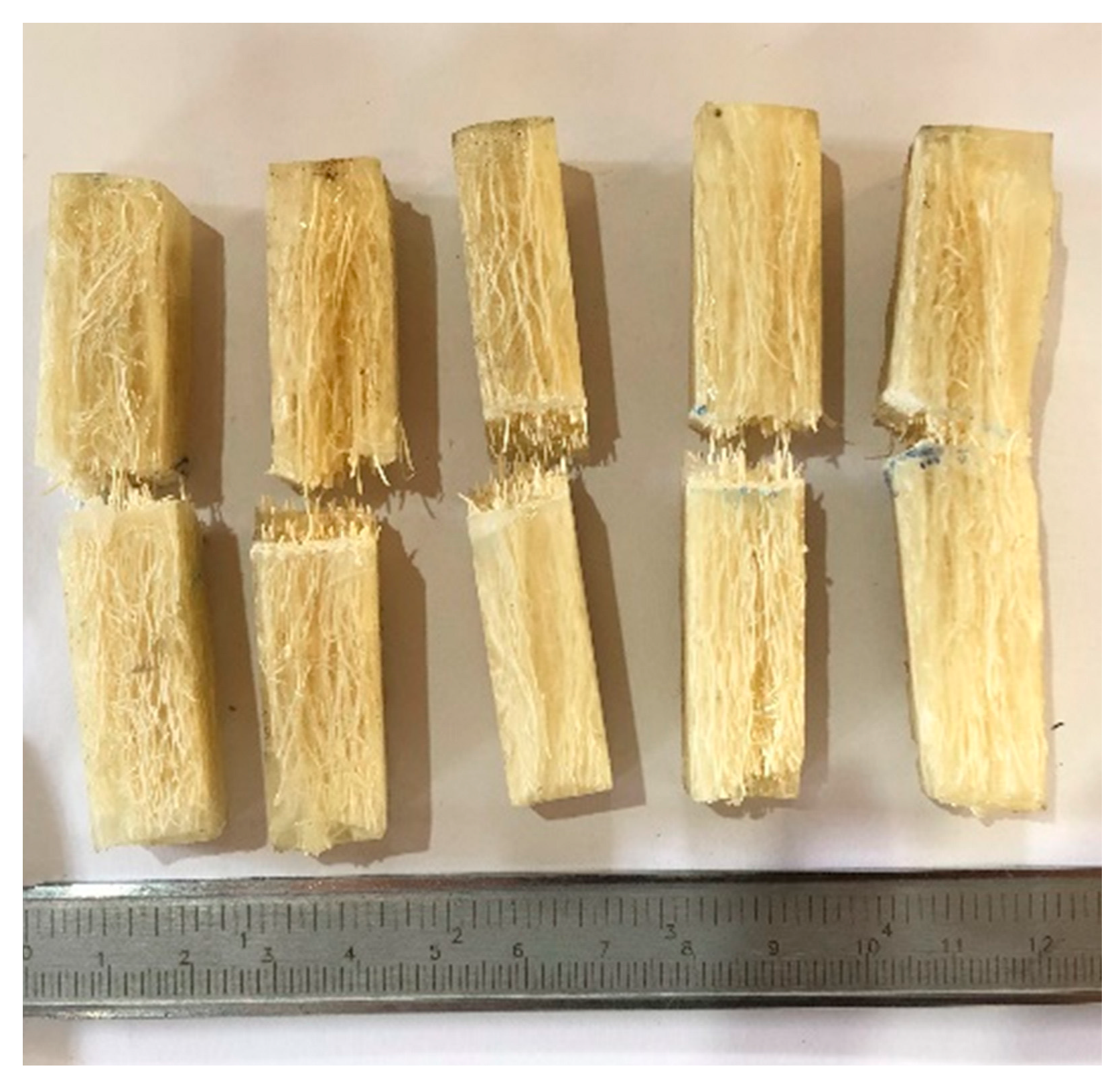
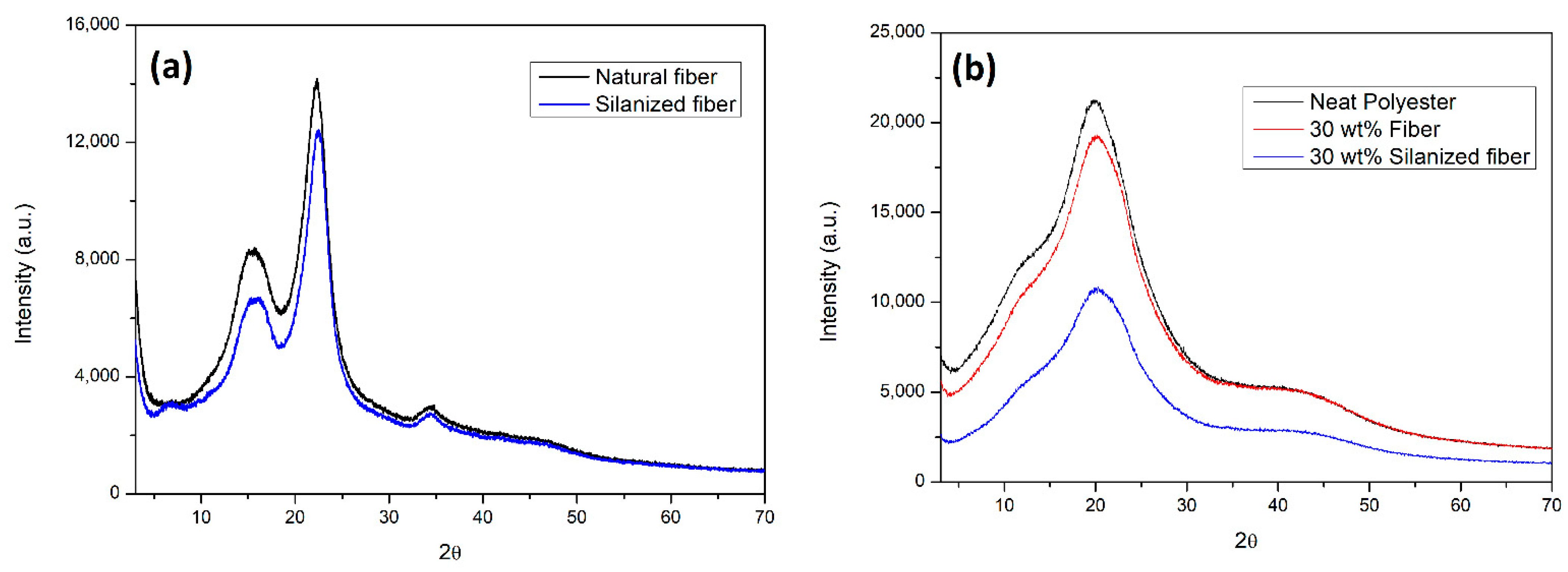
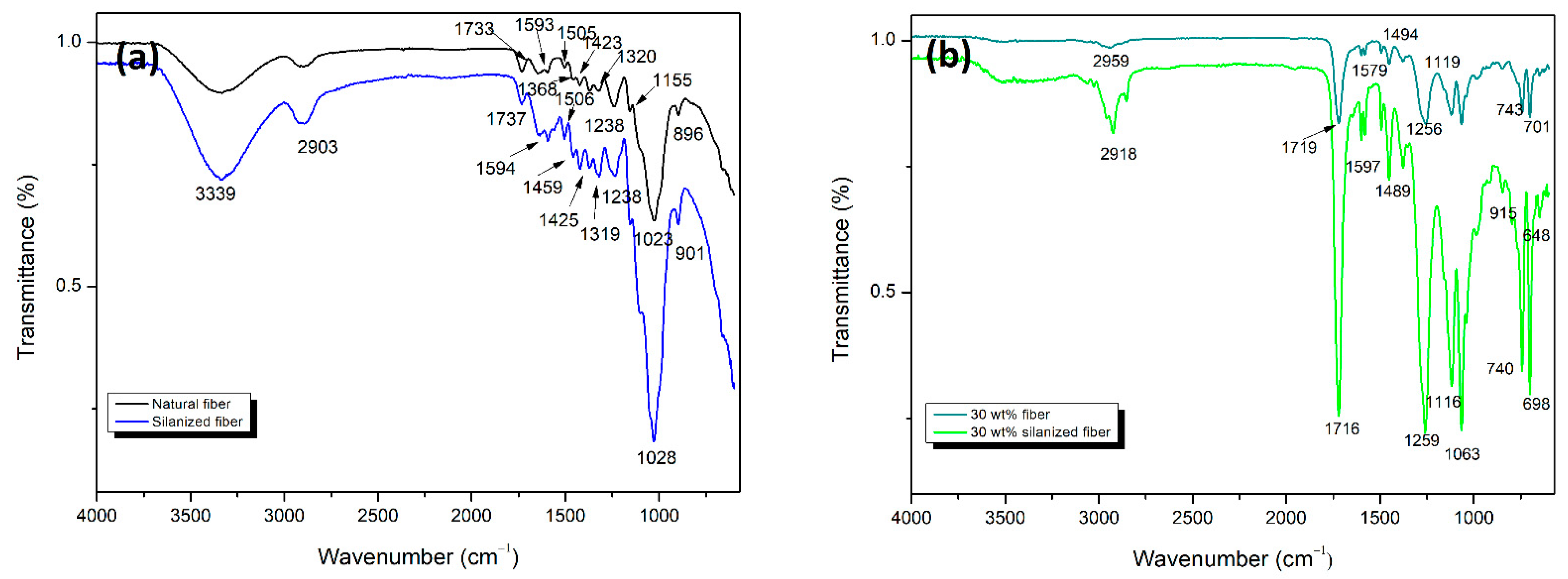
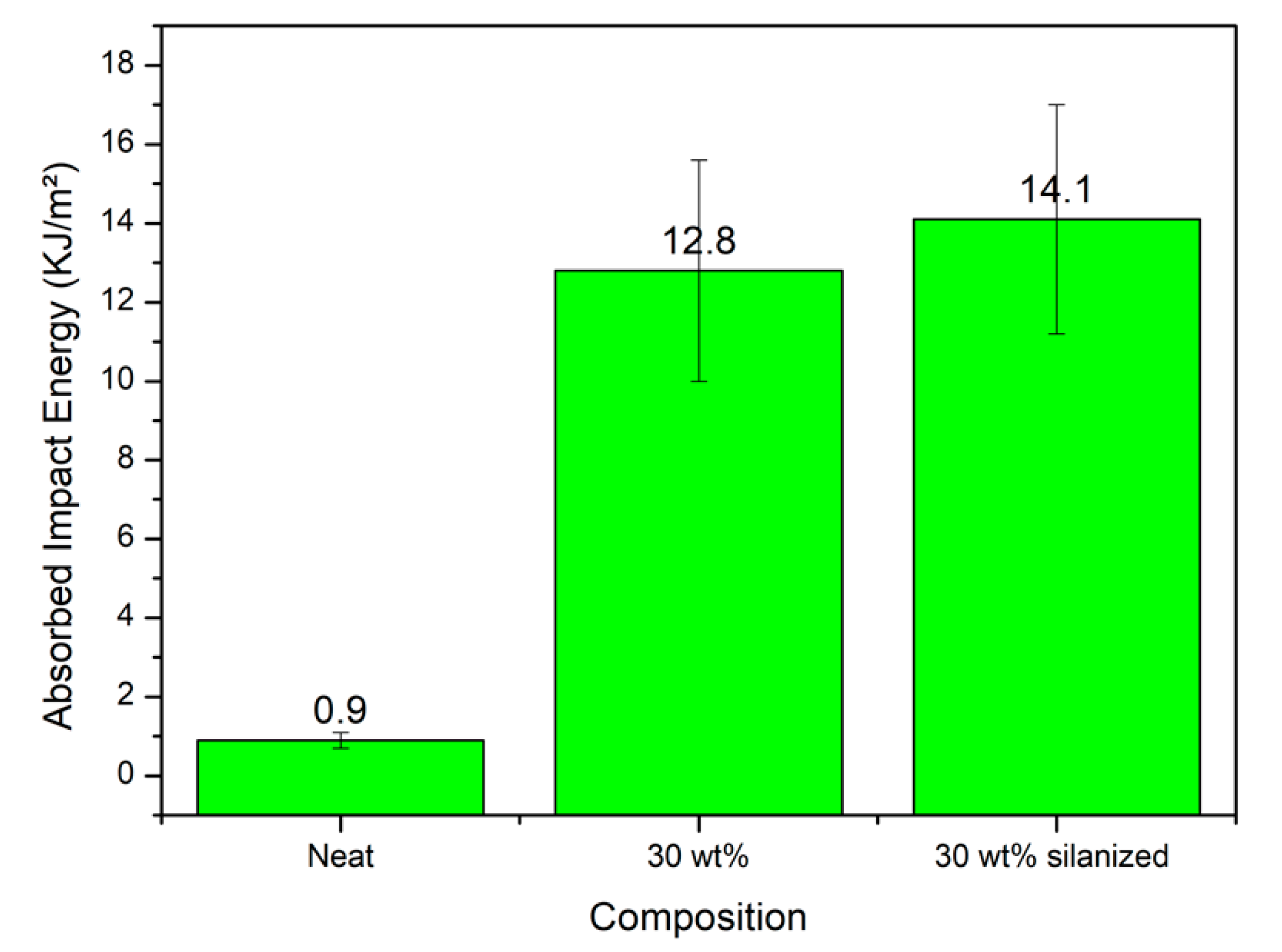
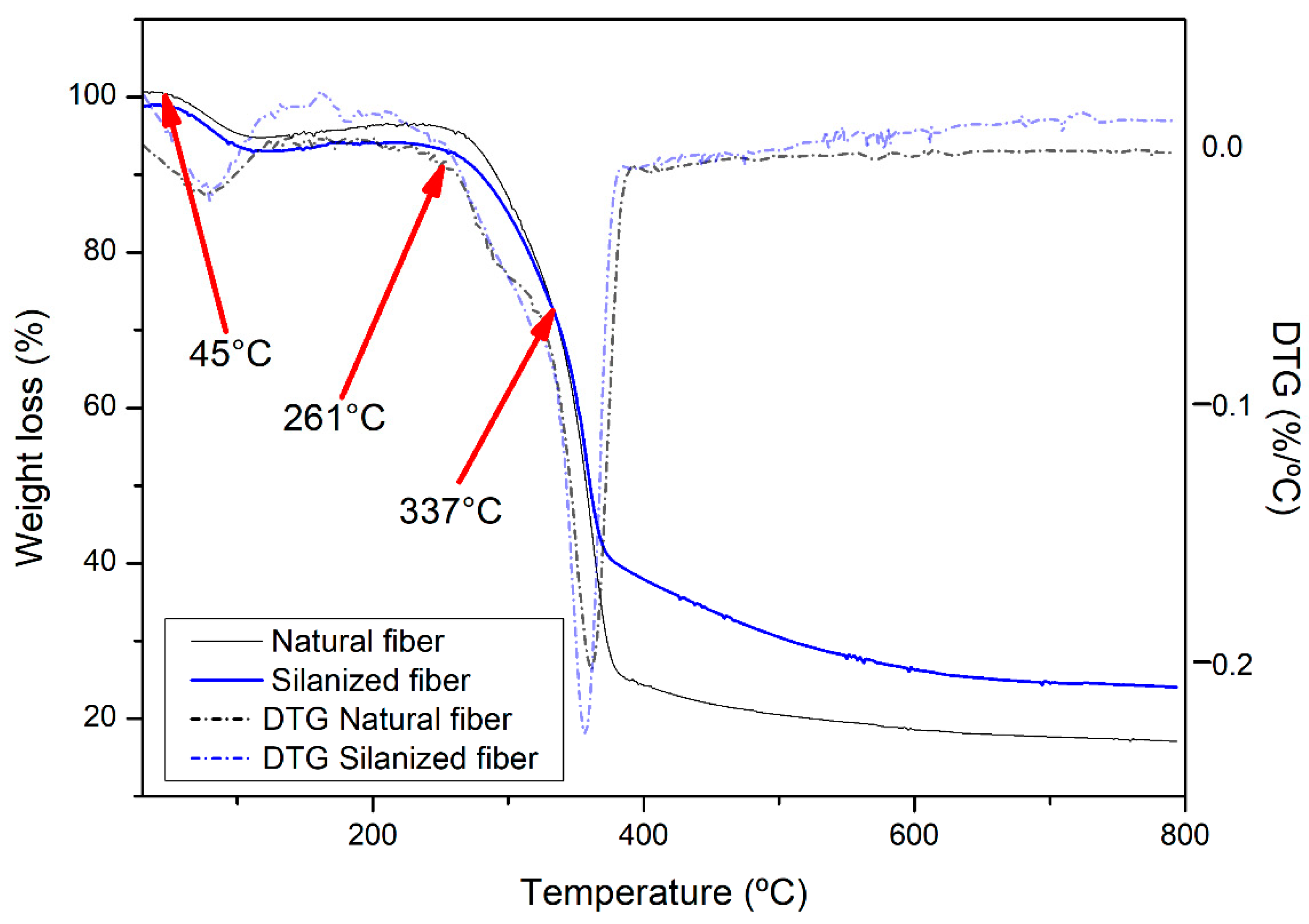
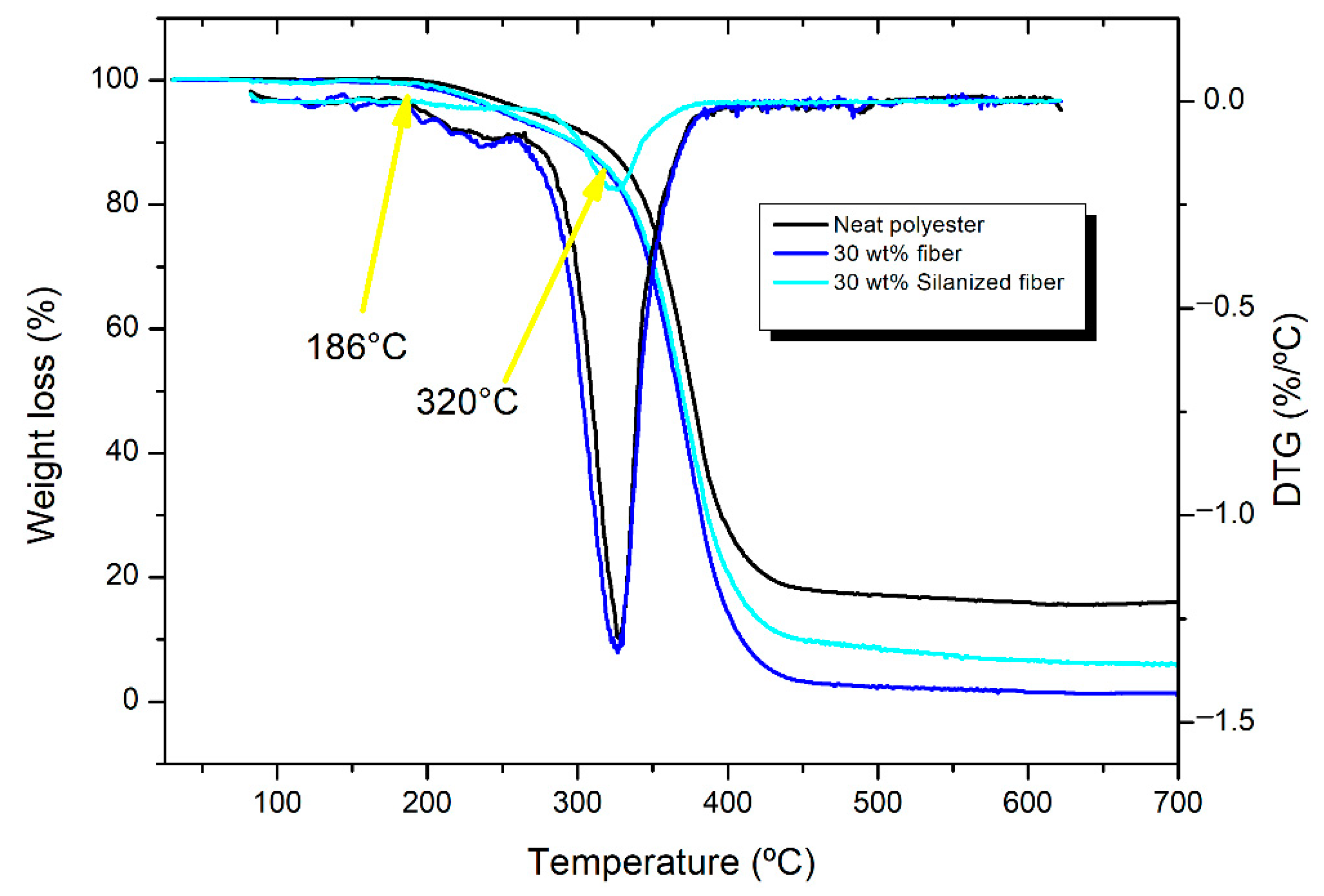

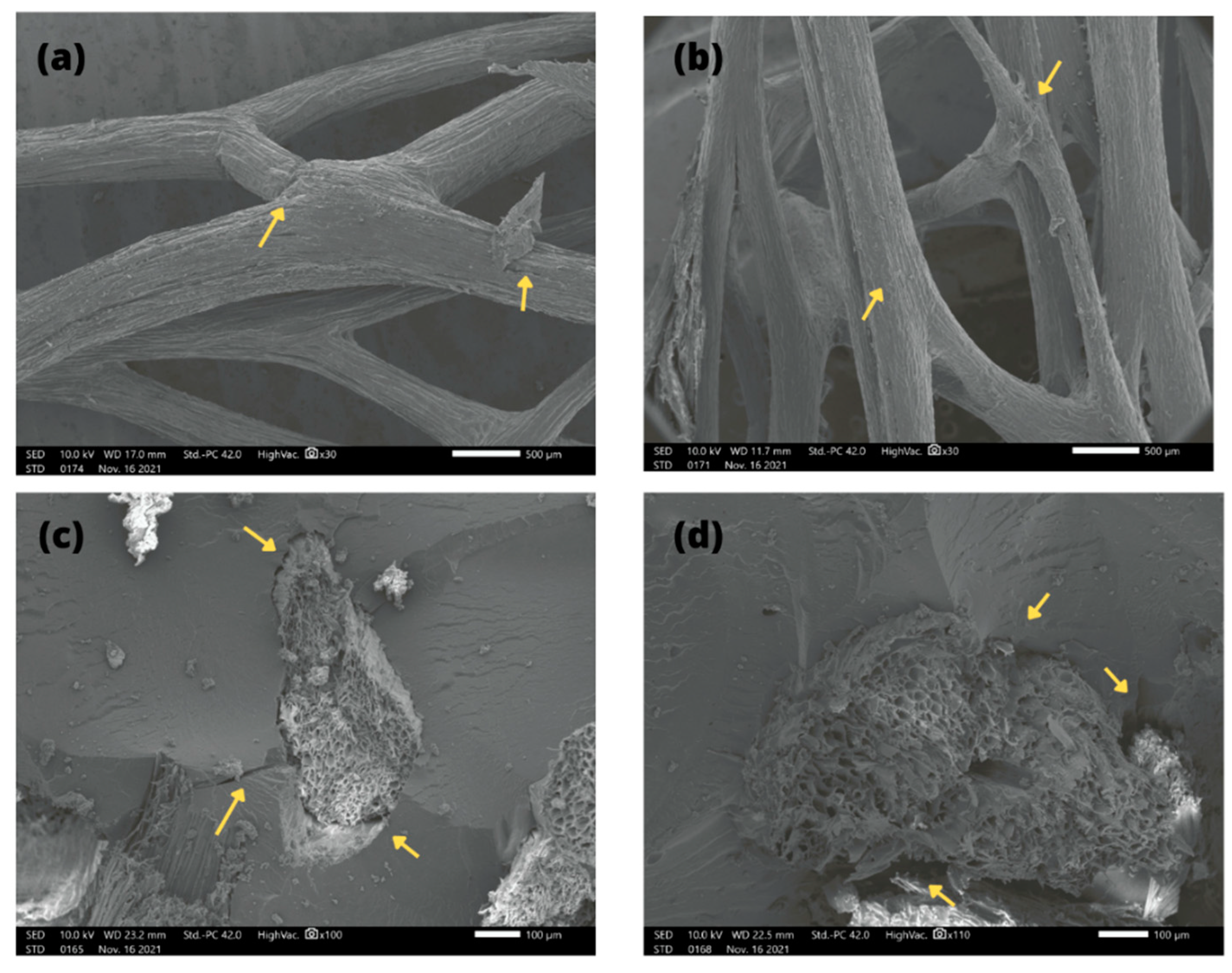
| Polymer | Fiber-Resin Ratio (wt.%) | Impact Strength (KJ/m2) | Tensile Strength (MPa) | Flexural Strength (MPa) | Young’s Modulus (GPa) |
|---|---|---|---|---|---|
| Polyester | 50:50 | 29.32 | 46.47 | 57.36 | 3.58 |
| Epoxy | 13:87 | 6.67 | 27.00 | 55.00 | 2.41 |
| HDPE | 40:60 | 34.70 | 20.80 | 37.70 | 1.08 |
| Polypropylene | 55:45 | 31.29 | 37.17 | 19.40 | 1.70 |
| Cellulose (%) | Hemicellulose (%) | Lignin (%) | Extractives (%) | Ashes (%) | |
|---|---|---|---|---|---|
| Natural fiber | 33.36 ± 1.30 | 38.44 ± 1.30 | 12.32 ± 0.49 | 12.15 ± 0.29 | 0.49 ± 0.05 |
| Silanized fiber | 36.26 ± 1.03 | 32.48 ± 1.03 | 20.47 ± 2.37 | 15.01 ± 0.13 | 8.24 ± 0.15 |
| LCF/Composites | Crystalline Index, CI (%) |
|---|---|
| Natural fiber | 73.56% |
| Silanized fiber | 77.76% |
| Neat polyester | 6.21% |
| 30 wt.% fiber | 6.67% |
| 30 wt.% silanized fiber | 9.16% |
| Sum of Squares | df | Mean Square | F | P (Same) | F (Critical) | |
|---|---|---|---|---|---|---|
| Between composites | 608.1347 | 4 | 152.0337 | 30.587 | 2.88 × 10−8 | 2.86608 |
| Within groups | 99.41067 | 20 | 4.970533 | |||
| Total | 707.5454 | 24 |
| Neat Polyester | 30 wt.% Fiber | 30 wt.% Silanized Fiber | |
|---|---|---|---|
| Neat polyester | 0.000132 | 0.0001319 | |
| 30 wt.% in natura fiber | 11.95 | 0.9137 | |
| 30 wt.% silanized fiber | 13.14 | 1.193 |
Publisher’s Note: MDPI stays neutral with regard to jurisdictional claims in published maps and institutional affiliations. |
© 2022 by the authors. Licensee MDPI, Basel, Switzerland. This article is an open access article distributed under the terms and conditions of the Creative Commons Attribution (CC BY) license (https://creativecommons.org/licenses/by/4.0/).
Share and Cite
Melo, E.C.R.d.; Camillo, M.d.O.; Marcelino, P.R.C.; Barbosa dos Santos da Silva, R.; Colares Firmino, T.; Ferreira de Oliveira, B.; Profeti, D.; Camposo Pereira, A.; Neves Monteiro, S.; Picanço Oliveira, M. Influence of Silanization Treatment of Sponge Gourd (Luffa cylindrica) Fibers on the Reinforcement of Polyester Composites: A Brief Report. Polymers 2022, 14, 3311. https://doi.org/10.3390/polym14163311
Melo ECRd, Camillo MdO, Marcelino PRC, Barbosa dos Santos da Silva R, Colares Firmino T, Ferreira de Oliveira B, Profeti D, Camposo Pereira A, Neves Monteiro S, Picanço Oliveira M. Influence of Silanization Treatment of Sponge Gourd (Luffa cylindrica) Fibers on the Reinforcement of Polyester Composites: A Brief Report. Polymers. 2022; 14(16):3311. https://doi.org/10.3390/polym14163311
Chicago/Turabian StyleMelo, Eduarda Chiabai Rodrigues de, Mayara de Oliveira Camillo, Paulo Roberto Correia Marcelino, Roseméri Barbosa dos Santos da Silva, Thierry Colares Firmino, Bárbara Ferreira de Oliveira, Demetrius Profeti, Artur Camposo Pereira, Sergio Neves Monteiro, and Michel Picanço Oliveira. 2022. "Influence of Silanization Treatment of Sponge Gourd (Luffa cylindrica) Fibers on the Reinforcement of Polyester Composites: A Brief Report" Polymers 14, no. 16: 3311. https://doi.org/10.3390/polym14163311
APA StyleMelo, E. C. R. d., Camillo, M. d. O., Marcelino, P. R. C., Barbosa dos Santos da Silva, R., Colares Firmino, T., Ferreira de Oliveira, B., Profeti, D., Camposo Pereira, A., Neves Monteiro, S., & Picanço Oliveira, M. (2022). Influence of Silanization Treatment of Sponge Gourd (Luffa cylindrica) Fibers on the Reinforcement of Polyester Composites: A Brief Report. Polymers, 14(16), 3311. https://doi.org/10.3390/polym14163311










